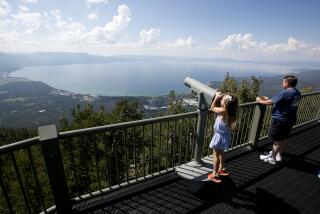Investment in Vacation Homes : Experts Advise Care in Selecting ‘Right’ Location
- Share via
With interest rates down and tax reform jitters over, thousands of investors are once again considering the purchase of a vacation home.
But before you buy a mountain hideaway or desert condo, experts say, you’ll have to do a lot of homework to maximize all the pleasure and investment potential a second home can provide.
Prices in most resort communities have been soft during the past two years, in part because Congress had considered reducing the tax benefits of owning vacation property while it worked on its sweeping tax-overhaul plan.
But the final compromise spared most of those deductions, and prices in many second-home areas are once again on an upswing.
Location Important
Still, experts advise, don’t buy a vacation home merely to generate additional tax deductions. “The most important thing a second home can provide is happiness for you and your family,” says Bob Flavin, a broker at HMS Realty in Palm Springs.
“Tax breaks and resale profits are important, but they should be secondary considerations.”
While the location of any property is always a key factor in selecting real estate, it takes on added importance if you’re thinking of buying a second home. Vacation properties with the best investment potential tend to be located near a natural amenity, such as an ocean, lake or mountain that is used as a ski run in winter.
“Golf courses and swimming pools can always be built, but you can’t replicate Mother Nature,” says Jay Lamont, director of Temple University’s Real Estate Institute in Philadelphia.
Ideally, he adds, you should buy the best home with the best view you can afford because it will likely appreciate at a rate faster than less expensive properties.
Another advantage to buying higher-end properties is that the market for them is more consistent. “There will always be buyers for the better properties because there will always be people who can afford to buy regardless of interest rates or tax laws,” says Charles Penwill, a sales agent in the winter resort of Vail Valley, Colo.
The market for lower-priced vacation homes is more dependent on which way rates are going. While plenty of middle-income buyers will be in the market when rates are low, their ranks thin out as rates rise because they can’t afford the higher monthly payments.
Most experts suggest shopping for a vacation property that’s within a few hours’ drive of their primary residence. “You’re not going to have much fun if you have to drive eight hours each way just to spend a weekend away from home,” says broker Flavin. “You might do it for awhile, but it’ll get old pretty fast.”
Easier to Rent Out
Buying close to home provides other benefits, as well. Homes that are fairly close to metropolitan areas are often easier to rent out or sell because there are larger pools of potential tenants or buyers.
And when energy costs are high, values in nearby resort areas tend to hold up better than prices in distant locations because people travel shorter distances on their vacations.
If you’re buying in a planned development, it’s important to check out the developer’s master plan. Make sure there are adequate controls on future construction, as well as proper design-review procedures.
“If there are no design guidelines, you can wind up with a bunch of weird-looking houses that ruin the atmosphere of the rest of the community,” says Fred Trower, owner of Bear Valley Springs Realty in Tehachapi. “Or, a neighbor can build a big house that blocks your view.”
If you’ll have to pay a monthly homeowners’ fee, check out the homeowner association’s operating budget and other financial statements.
“Make sure actual expenses are in line with projections,” Trower says. Proper reserves should also be set aside for major expenditures, such as the addition of a golf course or repairs of the clubhouse roof.
Some experts say you should be leery of new developments in which promised amenities aren’t yet built: They might not ever get built if the developer runs into financial trouble.
“If you’re buying in a brand-new community, at least make sure the builder has posted a bond to guarantee that the work will be completed,” Trower suggests.
Renting Out Property
It’s also important to determine whether the developer will transfer ownership and maintenance responsibilities of the amenities to local residents when the project is built out. If so, you should find out how much your monthly dues will rise when the changeover takes place.
If you’re on a tight budget, you might consider renting the property to others when you’re not using it yourself. Unfortunately, being a part-time landlord can become a full-time headache: You have to locate tenants, make arrangements to drop off keys and collect rent checks and security deposits.
You’ll also have to inspect the property after the rental period is over to make sure no damage was done and the place was cleaned up.
If you hire a management company to do all those things, the firm will typically want 30% to 50% of your rental income as a fee.
As an alternative, you might be able to find semi-retired people or other residents in the resort area who are willing to perform minor maintenance and clean-up duties for a flat fee of $25 or $50 per rental.
Rental Income Limited
Some property managers are also willing to make such an arrangement. You can find them by checking out community bulletin boards in the resort area, scanning church newsletters or the classified ads in local newspapers.
Even if you’re willing to rent out your vacation home, don’t expect rents to cover all of your monthly mortgage payments and related expenses.
“I’d guess that less than 10% of all vacation-home owners are able to break even each month, even if they rent their property out,” says Stan Ross, co-managing partner of the real estate consultancy of Kenneth Leventhal & Co.
Rental rates are often limited because the supply of rental housing in most resort areas exceeds demand, Ross says. Management costs and homeowners’ dues will eat further into your bottom-line.
In addition, he adds, “many resort areas have only one or two seasons that are in great demand. Palm Springs is a great place to go in the winter and spring, but tenants can be hard to find when the summer rolls around.”
Ironically, Ross notes, vacation-home owners who rely heavily on rental income to cover their monthly expenses often can’t use their place during peak seasons because that’s when their property will be in strongest demand.
Tax-reform has made it even tougher to turn a profit from a second-home investment. Generally, a vacation home that doubles as a rental property must be depreciated over 27 1/2 years if it was purchased after the start of this year. The old tax law allowed a 19-year depreciation schedule, which provided bigger annual tax deductions.
Still, the tax breaks that come with a second-home investment can be substantial. If you rent the home out for no more than 14 days a year, you can deduct your payments for mortgage-interest and property taxes. Although depreciation write-offs aren’t allowed for second homes that do not qualify as rental properties, you don’t have to show the rental income on your tax return.
Homes that are rented out for more than two weeks annually can provide other tax benefits. In addition to the write-offs mentioned above, you can depreciate the property for the length of time it was rented out and write off operating expenses incurred during the rental period. However, those deductions can’t exceed your total rental income.
Your write-offs will only be allowed to exceed your rental income if you’re willing to limit your personal use of the property to 14 days a year, or 10% of the number of days it is rented out. Other requirements must also be met, so it’s best to consult an accountant.
Once you’ve decided on purchasing a property, don’t be afraid to drive a hard bargain. In some weaker resort areas, buyers are reportedly picking up properties for 10% to 20% below the asking price--and sellers are willing to provide partial financing for the deal themselves at below-market interest rates.
Shopping around for the loan can pay big dividends. Lenders with a large presence in the resort area may offer better rates than your local lender. Developers, too, sometimes offer attractive financing terms in order to make their homes sell faster.
More to Read
Inside the business of entertainment
The Wide Shot brings you news, analysis and insights on everything from streaming wars to production — and what it all means for the future.
You may occasionally receive promotional content from the Los Angeles Times.










